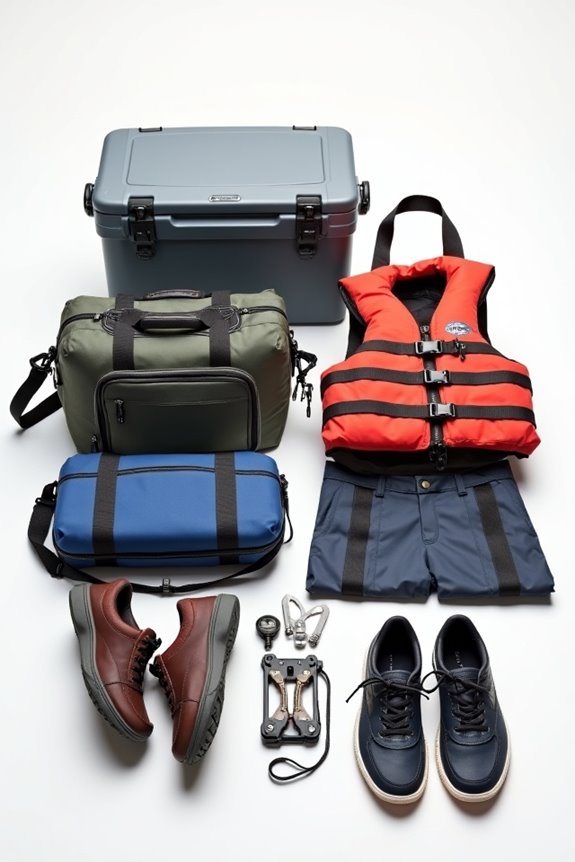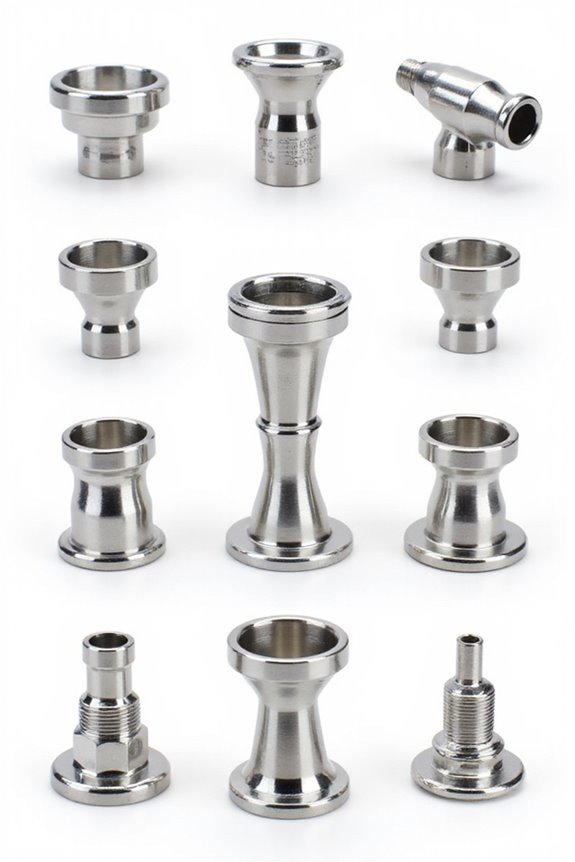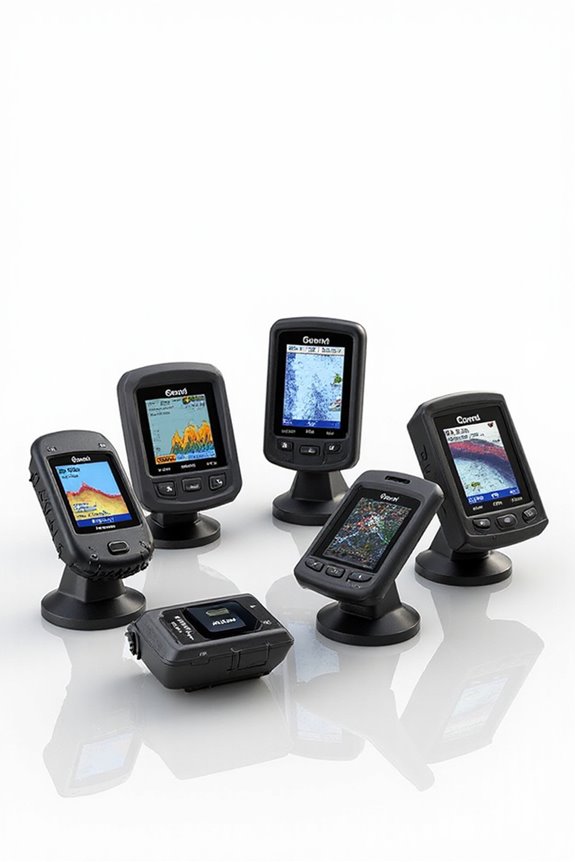As an Amazon Associate, we earn from qualifying purchases. Some links may be affiliate links at no extra cost to you. Although our opinions are based on curated research, we haven't used these products. Articles generated with AI.
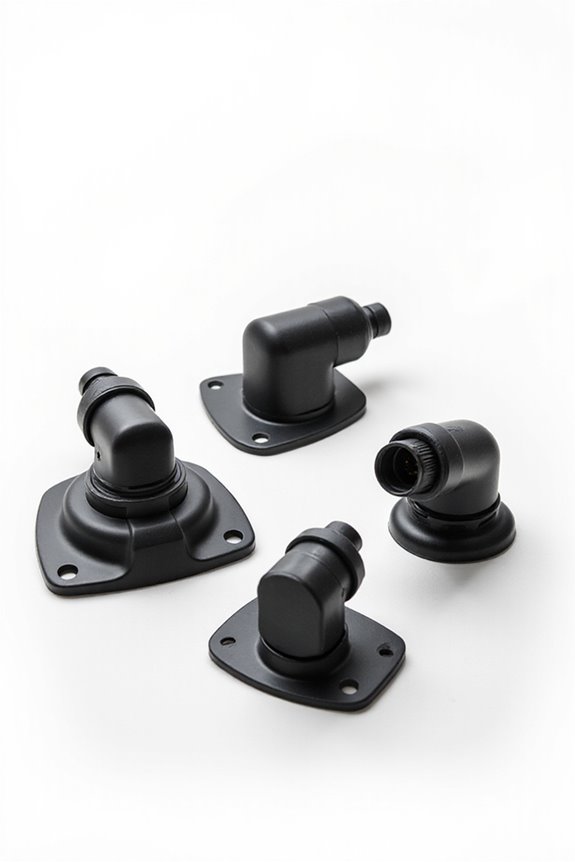
5 Best Forward-Looking Sonar Transducers for Enhanced Underwater Exploration
If you’re looking to amp up your underwater adventures, consider these five fantastic forward-looking sonar transducers: the Garmin STRIKER 5CV, Garmin Striker Vivid 7cv, the Live Mount System for quick releases, Garmin LiveScope, and Lowrance TripleShot. These devices feature high-resolution displays, enhanced GPS for marking spots, and easy mounting options. You’ll get clearer images, acknowledge what’s below, and have fun while fishing! Stick around to discover more about choosing the perfect sonar for your needs.
Key Takeaways
- CHIRP traditional sonar provides superior target separation and clarity for precise underwater imaging and fish detection.
- ClearVu scanning sonar enhances detail visibility, making it easier to identify structures and fish in various environments.
- SideScan sonar features offer wider coverage, allowing for effective exploration of large underwater areas.
- High-sensitivity GPS functionality within transducers aids in accurate waypoint marking and route planning for optimized fishing experiences.
- Compatibility with existing setups and easy installation enhance user experience and operational efficiency.
Garmin STRIKER 5CV GPS Fishfinder with Transducer
Garmin 010-01872-00 STRIKER 5CV with Transducer, 5" GPS Fishfinder, CHIRP Traditional And ClearVu...
- Includes transducer for built-in Garmin CHIRP traditional sonar plus CHIRP clearer scanning sonar
- Built-in Garmin quickdraw contours mapping software lets you create and store maps with 1’ contours for up to 2 million acres
- Built-in GPS lets you mark waypoints, create routes and view boat’s speed
If you’re out on the water and want to improve your fishing game, the Garmin STRIKER 5CV GPS Fishfinder with Transducer could be your new best friend. This nifty device features a 5-inch bright display that’s easy to read, even in the sun. With CHIRP traditional sonar and ClearVu scanning sonar, you’ll get a crystal-clear picture of what’s beneath the surface—no more guessing! Plus, the built-in GPS functionality lets you mark waypoints and track your progress. Want to map out that secret fishing spot? Garmin’s Quickdraw Contours mapping software can help you create and store maps! Who knew fishing could be this advanced?
Best For: Anglers and fishing enthusiasts who want to enhance their fishing experience with advanced sonar technology and GPS capabilities.
Pros:
- Clear Imaging: Comes with CHIRP traditional and ClearVu scanning sonar for detailed underwater views.
- User-Friendly Display: Features a bright, sunlight-readable 5-inch display that is easy to operate.
- Map Creation: Includes Garmin Quickdraw Contours mapping software for creating and storing custom maps.
Cons:
- Size Limitations: The 5-inch screen may be small for some users who prefer larger displays for viewing detailed images.
- Limited to 2 Million Acres: Mapping software is limited in terms of acreage compared to some competitor products.
- Additional Accessories: Some functions may require additional accessories for optimal performance, which can increase costs.
Garmin Striker Vivid 7cv Fishfinder with GT20-TM Transducer
Sale
Garmin Striker Vivid 7cv, U.S. with GT20-TM Transducer - Easy-to-Use 7-inch Color Fishfinder and...
- Easy-to-use 7” color fishfinder with new vivid scanning sonar color palettes to easily distinguish fish and structure; tilt/swivel bailmount bracket included
- Includes a GT20 transducer for built-in Garmin CHIRP traditional sonar and CHIRP ClearVü scanning sonar
- High-sensitivity GPS to mark waypoints, create routes and view your boat’s speed
Looking for a fishfinder that combines user-friendly features with powerful sonar technology? The Garmin Striker Vivid 7cv, paired with the GT20-TM transducer, is a game-changer! With its vibrant 7-inch color LCD display, you’ll spot fish like a pro. It uses Garmin’s CHIRP traditional and ClearVü scanning sonar, ensuring you get crystal-clear images beneath the water. Plus, its high-sensitivity GPS lets you mark waypoints to find your favorite fishing spots time and again. Weighing just 4.4 pounds, it’s easy to install and comes with all the necessary mounting hardware. Ready to enhance your underwater adventures? Immerse yourself!
Best For: The Garmin Striker Vivid 7cv is best for anglers seeking a user-friendly fishfinder with advanced sonar capabilities for enhancing their fishing experience.
Pros:
- Clear screen visibility enhances the ability to spot fish and underwater structures.
- High-sensitivity GPS allows for efficient waypoint marking and route planning.
- Mounting hardware included, making installation straightforward and hassle-free.
Cons:
- Some users have reported disappointment with the mapping capabilities.
- A few individuals encountered challenges regarding product specifications clarity.
- Expectations regarding the overall functionality may not be fully met for every user.
Live Mount System – Live Sonar Transducer Mount Pole – Quick Release (60)
Sale
Live Mount System - Live Sonar Transducer Mount Pole - Quick Release (60")
- The Salty Adventures Live Mount is engineered to securely hold a wide variety of transducers. Innovative design allows the unit to be quickly and easily removed for...
- Choose Pole Length (60" or 72") Pole Outside Dia: 1.38", Plate Thickness 3/8", Both Made from Anodized Aluminum, Includes 316SS Mounting Hardware, Ships in Two Boxes
- Compatible with Garmin Live Scope, Lowrance Active Target, and Humminbird Mega Live units (Transducer not included)
The Live Mount System for sonar transducers is a fantastic choice for anglers who want versatility without the hassle of complicated setups. With a quick-release feature, you can easily remove the transducer for storage, making it a breeze to switch between trips. Choose from pole lengths of 60, 72, or even 84 inches, depending on your needs. Made from anodized aluminum, this mount flexes on impact, giving you durability. Plus, its lever lock clamps allow for effortless height and angle adjustments. It works marvelously with popular units like Garmin Live Scope—because who wants to struggle with compatibility, right? Enjoy effortless exploration!
Best For: The Live Mount System is best for anglers seeking a durable and easily adjustable sonar transducer mount for quick setup and efficient storage.
Pros:
- Versatile compatibility with major sonar units like Garmin Live Scope, Lowrance Active Target, and Humminbird Mega Live.
- Quick release mechanism allows for hassle-free removal and storage of the transducer.
- Durable anodized aluminum construction that flexes upon impact, ensuring longevity.
Cons:
- Transducer not included, requiring separate purchase.
- Availability of only three pole lengths may not accommodate all user preferences.
- Some users may find the price compared to other mounts on the market to be higher.
Garmin LiveScope
Garmin LiveScope™ XR LVS62 Transducer Only, Live Scanning Sonar for Open Water, 500 ft Range in...
- Extended range live scanning sonar up to 500’ in freshwater and up to 350’ in saltwater
- The Reverse Range Offset feature uses more of the screen to display fish and structure up to 500’ in freshwater and 350’ in saltwater. And The Compress Range feature...
- Easily upgrade your system by using your GLS 10 black box; add the new LVS62 extended range transducer
For anglers looking to up their game on the water, the Garmin LiveScope is the go-to choice thanks to its incredible live scanning sonar capabilities. This transducer lets you see underwater action in real-time, with a range of up to 500 feet in freshwater—perfect for tracking fish. It’s compact, lightweight, and mounts easily to your trolling motor or using perspective mode. With vivid color palettes, you won’t miss the details! Plus, it comes with a two-year warranty—so you know Garmin’s got your back. Are you ready to bring home the big catch? Just don’t forget your fishing license!
Best For: Anglers who want real-time underwater visibility and advanced sonar technology to enhance their fishing experience.
Pros:
- Extended range: Offers live scanning sonar capabilities up to 500 feet in freshwater and 350 feet in saltwater for effective fish tracking.
- User-friendly: Easy to mount on various types of boats, including trolling motors, and comes with a vivid color display for clear underwater visuals.
- Durable warranty: Backed by a 2-year limited warranty, providing peace of mind for users.
Cons:
- Transducer only: Does not include a display unit, requiring users to have compatible Garmin chartplotters or fish finders.
- Weight: At 3.23 kilograms, it may be considered bulky for some users who prefer lighter gear.
- Price: The premium features come with a higher price point compared to basic fish finders.
Lowrance TripleShot Skimmer Transducer for Fish Finders
Sale
Lowrance TripleShot Skimmer Transducer for Hook Reveal and HOOK2 Fish Finders, BLACK
- TripleShot 3-in-1 Sonar Technology – Combines High CHIRP, SideScan, and DownScan Imaging for comprehensive underwater views and superior fish targeting.
- Wide-Angle CHIRP Coverage – Delivers double the sonar coverage of traditional fishfinders, making it easier to locate fish across a broader area.
- Picture-Like Imaging – SideScan and DownScan frequencies (455/800 kHz) provide lifelike views of structure and fish beneath and beside your boat.
Ready to elevate your fishing experience? The Lowrance TripleShot Skimmer Transducer is your trusty sidekick for exploring underwater like never before. Compatible with HOOK Reveal and HOOK² models, it offers DownScan and SideScan sonar, extending your reach up to 300 feet on each side. With CHIRP providing those fish arch views, you’ll feel like a pro in no time! Installation’s a breeze—just mount it to your transom, and you’re set. However, some users have reported durability issues, so consider snagging an extended warranty. With a 4.5-star rating from 519 customers, this transducer’s definitely making waves in the fishing world!
Best For: Anglers looking for an advanced sonar system to enhance their fishing experience with detailed underwater views.
Pros:
- Easy Installation: Simple to mount on the transom, making it accessible for all users.
- Wide Coverage: Offers expansive sonar coverage with DownScan and SideScan sonar capabilities, reaching up to 300 feet on each side.
- High Ratings: Enjoys a strong customer rating of 4.5 out of 5 stars, indicating overall satisfaction among anglers.
Cons:
- Durability Concerns: Some users have reported issues with breakage and durability, especially after impacts.
- Customer Service Challenges: Difficulty in reaching customer support for solutions has been noted by several customers.
- Extended Warranty Recommended: Given the reported durability issues, an extended warranty may be advisable for peace of mind.
Factors to Consider When Choosing a Forward Looking Sonar Transducer
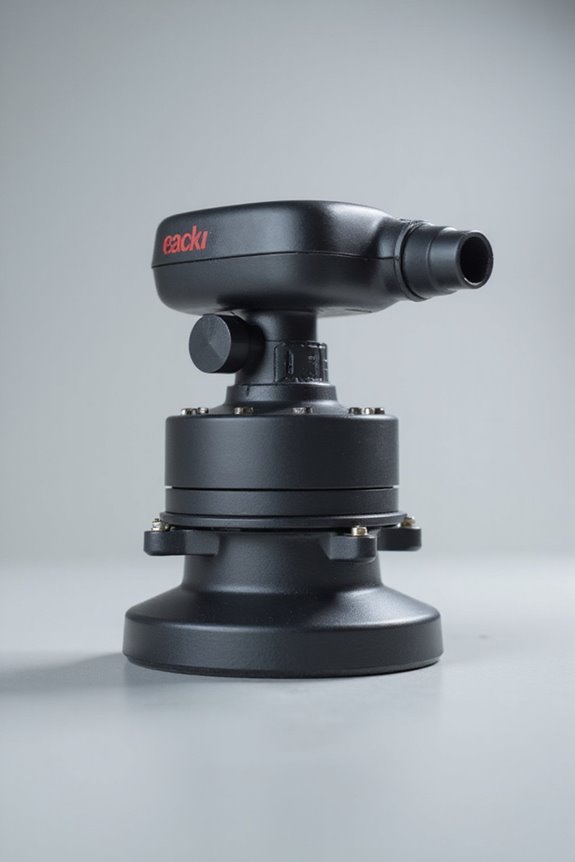
Choosing the right forward-looking sonar transducer can feel overwhelming, but it doesn’t have to be! You’ll want to think about sonar technology options, display clarity, and even how easy it is to mount. Plus, don’t forget about GPS features and overall durability—after all, you don’t want your transducer to do the underwater tango with a rock!
Sonar Technology Options
When you’re diving into the world of forward-looking sonar transducers, a few key elements can really make or break your underwater adventures. First off, consider the different sonar technologies out there—like CHIRP traditional and ClearVu scanning sonar. They offer enhanced imaging, each using different frequencies for fish detection. Plus, features like DownScan and SideScan sonar let you cover more underwater ground, revealing hidden treasures. Don’t forget about high-sensitivity GPS; it helps you mark waypoints and craft routes for smoother navigation. And hey, it’s essential to check compatibility with your current setup. Some systems might need specific mounts or extra gear to function at their best. You want to make sure everything works seamlessly before you cast off!
Display Size and Clarity
Have you ever squinted at a tiny screen, trying to decipher underwater images during a sunny day? If so, you know how essential display size and clarity are when choosing a forward-looking sonar transducer. Aim for a display of at least 7 inches; it really helps with visibility and detail, especially in bright sunlight. High-resolution screens enhance clarity, making it easier to spot fish and structures. Plus, color displays with vivid palettes can make information pop, letting you interpret data more quickly. Don’t forget about sunlight-readable screens—they reduce glare and improve your overall viewing experience. Combine all these factors with a user-friendly interface, and you’ll be set for effective underwater exploration without the frustration of squinting!
Mounting Compatibility and Ease
Selecting the right mounting system for your forward-looking sonar transducer can feel a bit like matching socks in a dark room—it’s essential but not always straightforward! First off, check if your transducer’s compatible with your existing fish finder or sonar system, since not all play nicely together. You’ll want a mounting type that fits your boat’s setup, whether that’s a transom mount or a trolling motor shaft mount. Easy installation is key; transducers with straightforward mounting options can save you time and headaches. Also, look for included hardware for various mounting types—more versatility means you can adapt to different boat designs. Ultimately, consider design features like cable routing and lever lock clamps for better durability and adjustments!
GPS Functionality and Mapping
GPS functionality and mapping are game-changers for forward-looking sonar transducers, and here’s why: imagine being able to mark your favorite fishing spots with pinpoint accuracy! With built-in GPS, you can easily create and store detailed maps that cover vast areas—some models even let you map up to 2 million acres. Plus, seeing your boat speed right on your display helps you adjust your fishing strategies on the fly. Don’t forget the value of high-sensitivity GPS systems, which keep your route planning precise, so you never lose track of where you’re going. You can even customize maps based on your preferences, turning every trip into a tailored adventure. What’s not to love about that? Happy fishing!
Durability and Build Quality
When you’re out on the water, having a dependable forward-looking sonar transducer is just as important as knowing where to cast your line. To guarantee durability, look for transducers made from robust materials like anodized aluminum or high-quality plastic. They can handle harsh marine environments, just like you! Designs that feature internal cable routing protect against abrasions, boosting lifespan. Also, consider models with a flex design; they absorb shocks and reduce breakage, especially when you’ve got a bit of adventuring to do. Quick release features are handy for easy storage, minimizing wear when your transducer isn’t in use. Finally, check warranty lengths; longer warranties usually suggest a manufacturer’s confidence in their product’s build quality. Happy exploring!
Frequently Asked Questions
What Is the Best Frequency Range for Forward-Looking Sonar Transducers?
The best frequency range for forward-looking sonar transducers usually lies between 200 kHz and 1 MHz. You might wonder why that range? Well, higher frequencies provide better resolution, which helps you detect smaller objects. However, they tend to have a limited range. Lower frequencies, while offering longer detection distances, sacrifice some detail. So, you’re balancing between clarity and range—like picking between a clear photo and a distant landscape shot!
How Do I Install a Forward-Looking Sonar Transducer?
Installing a forward-looking sonar transducer‘s easier than it sounds, trust me. First, find the right spot on your boat—preferably on the hull where it’ll get a clear view underwater. Clean the area well, then mix up some marine adhesive to secure the transducer. Next, connect the wiring according to the manual; don’t worry, they’re usually pretty straightforward. Finally, test it out before you head out—make sure it works, or you might end up swimming!
Can I Use Sonar Transducers for Navigation Purposes?
Absolutely, you can use sonar transducers for navigation! They help you see underwater obstacles, guiding your boat safely through tricky waters. Think of them as your sonar sidekick—detecting objects ahead, like rocks or other vessels. Just remember, while they’re great at what they do, they shouldn’t replace traditional navigation tools completely. It’s like combining the perfect playlist with a trusty compass—each has its role in making your journey easier and more enjoyable!
Are Forward-Looking Sonar Transducers Compatible With All Fish Finders?
Not all forward-looking sonar transducers are compatible with every fish finder out there. Some units only work with specific brands or models, so it’s essential to check compatibility before making any purchases. Think of it like dating; you want the right match! If you’re not sure, consult the manufacturer’s specs or reach out to customer service. A little research saves you from future headaches and keeps your fishing adventures smooth. Happy angling!
How Do I Troubleshoot Issues With My Sonar Transducer?
Troubleshooting your sonar transducer can feel like finding Waldo in a sea of stripes. First, check your connections; guarantee everything’s tight and corrosion-free. Next, inspect the transducer for damage or debris that might be blocking signals. If it still isn’t working, reset your fish finder to factory settings. Don’t forget to update the software! Sometimes, all it takes is a little tech TLC to get things swimming smoothly again.






